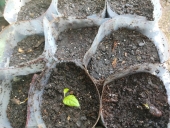Hey - maybe it's a bit presumptious of me to go first as I'm in Europe where asimina trees are not native. In Georgia they likely are, so that's a bonus for you from the start.
See:
-
https://www.facebook.com/GeorgiaNativePlant/posts/six-species-of-paw-paw-call-georgia-home-from-the-coastal-plain-to-piedmont-and-/1479037145449139/
-
https://gnps.org/plants/pawpaw-asimina-triloba/
Anyway, we have 2 grown trees that I've had the opportunity of observing for 10 years. They gave a crop this year for the first time (have been trying for the last 5 years but various misfortunes befell us). It was glorious.
- Acidic soil should be OK considering that ours is pH 4.5-5.5.
- Asimina is an understory tree. Young plants can get sunburn if exposed to strong sun. Morning sun + afternoon shade is a good idea. Most of the growers I know even use shadecloth around young plants for the first 3 years after planting. You didn't ask, but: asimina can grow quite nicely near a walnut tree and will enjoy the shade if the walnut is on the south side of it.
- Apart from super sunny sites it's also a good idea to avoid very windy ones. Again, think of the natural situation of an understory tree. The alpha trees, let's call them that, are filtering down the level of both sun and wind.
- It would be good to avoid standing water; yes, mounds should be fine, or a slope if one is available. Our situation is not waterlogged so I don't have first-hand experience with planting on mounds. What you mentioned about planting shallowly and then building the mound around the rest of the rootball doesn't sound wrong. Just bear in mind that your freshly piled material will compress with time (and rain) so you likely need to pile up more than the final intended height. (Not hugely more - just somewhat more and then keep adding as needed.) A large (wide) mound would, in my opinion, be better than just a small pile around the roots so that you don't get struck by Murphy's law in the form of an unexpected drought - during which a very small mound and the roots inside it would be in danger of drying out. Yes, asmina will grow a serious taproot which will make it somewhat drought-resilient but not instantly after planting.
- As to adding other materials to the planting site, I like to include splinters of old wood (think buried hugel) but our situation is opposite to yours: a lack of rain, not an overabundance of it, is the usual challenge. Compost is always welcome. Oh and - loosen the soil deepy, ie. make an extra deep planting hole and then re-fill it to the actual intended depth so that there is a lot of loosened soil under the roots, making it easier for the taproot to develop.
- Planting in the fall should be fine - since your zone is 8b and our land is 1 or 2 zones harsher than that. If you're really worried you can pile up leaves, straw or whatever to give extra protection, but - it's a good idea to always keep mulch some distance from the tree trunk (to avoid excess moisture, critters partying, etc) and when your rootball is not yet wide, this means that your mulch will not be directly on top of it anyway. If i were in zone 8 I would be very, very much inclined to plant in the fall (as I am anyway) in order to avoid your spring-planted tree being exposed to summer heat while still entirely fresh in the ground.
I hope these are useful starting points and people with more years / trees will join in.

 1
1





 2
2




 1
1





 1
1











